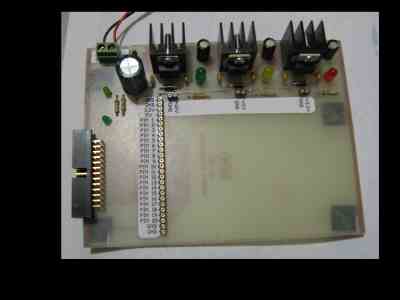
|

|
Forum Index : Microcontroller and PC projects : (MM DM UBW) Breadboard Setup Idea
| Author | Message | ||||
| jwettroth Regular Member Joined: 02/08/2011 Location: United StatesPosts: 71 |
My main interest in the Maximite is as an electronics prototyping tool. I have been searching for a convenient platform for initially playing with IC Chips and Sensors. Most chips have I2C or SPI or other digital I/O and it's very convenient to have a system that lets you plug in a part, write a bit of code to tickle and read it's inputs and outputs and display the results withut resorting to assembly language and logic analyzers, etc. Below are a few pictures of the setup that I made for the Dontronics SM1 but its applicable to any of the brothers or cousins of the Maximite discussed here. Photo 1 is a overview with the SM1 on the left, a cable to a sort of breakout board, a first small breadboard and a second main breadboard. The first breadboard is a small breadboard cut in half. It is used to bring the wires from the breakout board down where they can be used. This board is numbered and I made the pin numbers on the BB line up with the MM pins- 1-20. I used different wire color for the 1-10 as for 11-20 as a reminder of the 3v/5v limits. Photo2 is a closeup to give a little detail on the breakout board. It's just a piece of copper clad perf board with a double row header to take the ribbon from the SM1 and some right angle pin strips to give a convenient test point for a logic analyzer or scope. (not really necessary but something that I did earlier) Photo 3 gives a view of how its is used. On the breadboard section is a seven segment LED display, supported by dropping resistors that I have connected to pins 11-17 in 5v open drain mode (mode 9). I was quickly able to write a little basic program to put numbers up, etc and play around a bit. Also in this photo, you can see an orange and red led- these are conected with (dropping resistors) to the 3.3 and 5v busses from the MM and give you a bit of confidence that things are connected. What I like about the system is that its simple and keeps me from miscounting pins on the 26 pin connector, etc. I think the labelling could be improved a bit to let me know what special pin functions are (i2c, serial, counters) but it serves my needs pretty well. Photo 1 Photo2 Photo3 John Wettroth |
||||
donmck Guru Joined: 09/06/2011 Location: AustraliaPosts: 1313 |
Nice work John, and not to detract, but to give an alternative. If users want to go via an Arduino shield, there are two boards designed for the MaxiMite, that will help the accessing the GPIO pins. The DonDuino Cross, which will allow many access points to be used: http://www.dontronics-shop.com/the-donduino-cross.html/ 
This can be on a length of cable, and further pictures of how this cable can be used, can be seen at the above URL. And the DonDuino Patch plugged into the Cross, has easy to read labels, and allows for both male and female jumper wires to be used: http://www.dontronics-shop.com/the-donduino-patch.html/ 
This can also be used to patch any GPIO PIN to any other PIN position on the Arduino stack-able principle. Cheers Don... https://www.dontronics.com |
||||
| aargee Senior Member Joined: 21/08/2008 Location: AustraliaPosts: 255 |
Nice, John A decent commercial breadboard interface doesn't seem to exist, home made is the way to go! Here's mine ... Maxistrip - Rob. For crying out loud, all I wanted to do was flash this blasted LED. |
||||
| centrex Guru Joined: 13/11/2011 Location: AustraliaPosts: 320 |
Here is my home brew version of a prototyping board, single sided pcb. The blank area will have a breadboard as soon as I can get one, there is only two jumpers on the whole board. 
Cliff |
||||
| rhamer Senior Member Joined: 06/06/2011 Location: AustraliaPosts: 174 |
At least some acknowledgement of what you copied would have been nice. Rohan Hamer HAMFIELD Software & Hardware Solutions Makers of the Maximite Expander. http://www.hamfield.com.au |
||||
| jwettroth Regular Member Joined: 02/08/2011 Location: United StatesPosts: 71 |
Nicely done guys! What a great resource this board and the Maximite community is. I've played with a few things so far on the breadboard- here is my list of things that I want to play with over the winter holidays. I suspect that many of use have a few items like this that we bought but have never quite gotten over the inertia to play with. I hope this BB system will give me the push that I need. Graphics LCD Displays- I have several cats and dogs that I've acquired over the years. I won't be happy until I see a crisp basic generated sine wave on each. A Wiznet ethernet module that I originally bought for the Propeller Chip. I have an old CNC machine that can take in programs with Kermit over a serial port. I have allways wanted to make a gadget that sat on my ethernet and was sort of a kermit server. AM/FM radio modules. I have several of these like a SiLabs Si4703 receiver from Sparkfun, an NXP TEA5767 FM module from Ebay and some others. An electronic compass chip- HMC6532. It would be fun to take in the raw inputs and make some corrections using floating point trig functions to massage the output. This should get me through the holidays... Take care and thanks all for sharing. John Wettroth |
||||
donmck Guru Joined: 09/06/2011 Location: AustraliaPosts: 1313 |
Hmmmmmm...... Or as Sparkey would have said: ...///... Cheers Don... https://www.dontronics.com |
||||
CircuitGizmos Guru Joined: 08/09/2011 Location: United StatesPosts: 1425 |
I could almost write a program to do that. *snort* On-topic, though, is the fact that the Maximite is great for checking out these devices before you have to deal with them in another design. In other words: If you intend to connect a little PIC or AVR to a SPI device (or serial or I2C) it is easy to learn the ins and outs of the SPI device using a Maximite first. Use the power and ease of the Maximite _before_ you have to write firmware for a little processor. Micromites and Maximites! - Beginning Maximite |
||||
James_From_Canb Senior Member Joined: 19/06/2011 Location: AustraliaPosts: 265 |
I really like the led display idea. It would help me know the signals are at least corect before they get to my cIrcuitry. Is there a simple way to use 2 sets of led blocks, (or a multicolor single block, if they exist) to show whether a pin is an output or an input? Preferable so the leds line up with the pins? James My mind is aglow with whirling, transient nodes of thought careening through a cosmic vapor of invention. Hedley Lamarr, Blazing Saddles (1974) |
||||
| aargee Senior Member Joined: 21/08/2008 Location: AustraliaPosts: 255 |
James, Well, no. If a pin is set as an input, it is essentially floating. When pins are set as outputs, depending on their configuration, can be floating as well. If you really want to test pins as inputs, you could have a simple 555 running as low speed square wave generator and connect it in place of the common for the LED resistors in the above circuits (maybe with a jumper), then have a program to sequentially test each suitable pins ability to act as an input. I don't have MM access a present, so just thinking off the top of my head... - Rob. For crying out loud, all I wanted to do was flash this blasted LED. |
||||
| paceman Guru Joined: 07/10/2011 Location: AustraliaPosts: 1329 |
If you really want to test pins as inputs, you could have a simple 555 running as low speed square wave generator and connect it in place of the common for the LED resistors in the above circuits (maybe with a jumper), then have a program to sequentially test each suitable pins ability to act as an input. ROB Could it be done with one of those two lead bi-colour LED's that are red or green depending on which direction the current's flowing? |
||||
James_From_Canb Senior Member Joined: 19/06/2011 Location: AustraliaPosts: 265 |
I wasn't thinking of using them to test the pins per se - I mean, once they're tested you know the connections and pin allocations are OK, so you don't really need the LEDs any more. I was wondering whether the LEDs could be used to show when data was being sent from or received by the Maximite. That would be useful in the longer term. I'm a numpty at hardware, so excuse stupid questions. This thread is similar to Talbit's posting about pin testing, but this seemed a better thread to ask the question. James My mind is aglow with whirling, transient nodes of thought careening through a cosmic vapor of invention. Hedley Lamarr, Blazing Saddles (1974) |
||||
| centrex Guru Joined: 13/11/2011 Location: AustraliaPosts: 320 |
My apologies to Rohan, but I did say it was a homebrew version. It is a visual copy but thats about it, it is single sided with the pinout that follows the MaxiMite pinout exactly. The board only requires 2 jumpers in the power supply section. regards Cliff |
||||